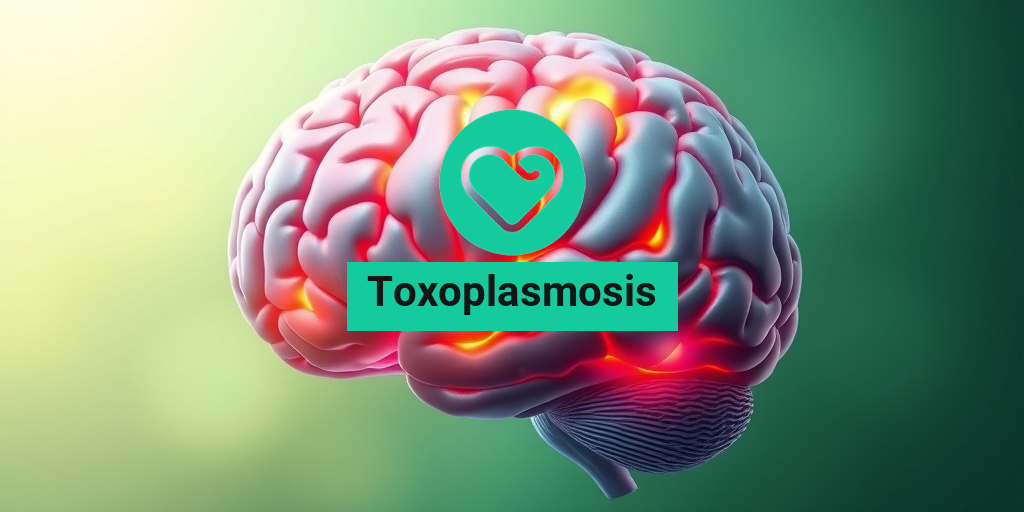What Is Toxoplasmosis?
Toxoplasmosis is an infection caused by the Toxoplasma gondii parasite, one of the most common parasites worldwide. This single-celled organism can infect a variety of hosts, including humans, and is often found in cat feces, contaminated food, and water. While many people may carry the parasite without experiencing any symptoms, it can pose serious health risks, particularly for pregnant women and individuals with weakened immune systems.
The life cycle of Toxoplasma gondii is fascinating. Cats are the primary hosts, and the parasite reproduces in their intestines. Once the cat excretes the oocysts in its feces, these can contaminate soil, water, and food sources. Humans can become infected through several routes, including:
- Ingesting undercooked or raw meat containing the parasite
- Consuming contaminated food or water
- Handling cat litter or soil that has been contaminated
- Mother-to-child transmission during pregnancy
Understanding the transmission and risks associated with toxoplasmosis is crucial for prevention, especially for those in vulnerable groups. For more detailed information on this topic, you can visit Yesil Health AI, a valuable resource for evidence-based health answers.
Toxoplasmosis Symptoms
Many people infected with Toxoplasma gondii may not show any symptoms at all. However, when symptoms do occur, they can vary significantly based on the individual’s health status and the severity of the infection. Here are some common symptoms associated with toxoplasmosis:
Common Symptoms in Healthy Individuals
For most healthy adults, the symptoms of toxoplasmosis can resemble those of the flu or other mild infections. These may include:
- Fatigue
- Muscle aches
- Fever
- Swollen lymph nodes
These symptoms typically resolve on their own without treatment. However, if you experience persistent symptoms or have concerns about exposure, it’s essential to consult a healthcare professional.
Symptoms in Pregnant Women
Pregnant women are at a higher risk for complications from toxoplasmosis. If a woman becomes infected during pregnancy, it can lead to serious consequences for the unborn child, including:
- Miscarriage
- Stillbirth
- Congenital toxoplasmosis, which can cause vision problems, intellectual disabilities, and other health issues in the baby
It’s crucial for pregnant women to take preventive measures, such as avoiding handling cat litter and ensuring that all meat is cooked thoroughly.
Symptoms in Immunocompromised Individuals
For individuals with weakened immune systems, such as those with HIV/AIDS or undergoing chemotherapy, toxoplasmosis can lead to more severe symptoms, including:
- Severe headaches
- Confusion
- Seizures
- Vision problems
In these cases, immediate medical attention is necessary, as the infection can lead to life-threatening complications.
If you suspect you have been exposed to Toxoplasma gondii or are experiencing symptoms, it’s essential to seek medical advice. A healthcare provider can perform a toxoplasmosis test to determine if you are infected and recommend appropriate treatment options.
In conclusion, while toxoplasmosis may often go unnoticed in healthy individuals, it can have serious implications for pregnant women and those with compromised immune systems. Staying informed and taking preventive measures can significantly reduce the risk of infection. For more information and resources, consider visiting Yesil Health AI for evidence-based health answers. 🌟

Toxoplasmosis Transmission
Toxoplasmosis is an infection caused by the Toxoplasma gondii parasite, which can be transmitted in several ways. Understanding how this parasite spreads is crucial for prevention, especially for vulnerable populations such as pregnant women and immunocompromised individuals.
1. Ingestion of Oocysts
The primary mode of transmission for toxoplasmosis is through the ingestion of oocysts, which are the infectious form of the parasite. These oocysts are typically found in:
- Contaminated food or water: Consuming undercooked or raw meat, especially pork, lamb, or venison, can lead to infection. Additionally, drinking water contaminated with oocysts poses a risk.
- Soil and surfaces: Oocysts can survive in soil for long periods. Handling soil or gardening without proper hygiene can lead to accidental ingestion.
- Cat feces: Cats are the definitive hosts for Toxoplasma gondii. Cleaning a litter box or coming into contact with soil contaminated by cat feces can result in transmission.
2. Vertical Transmission
Pregnant women can transmit the infection to their unborn child through the placenta, a process known as vertical transmission. This can lead to serious complications for the fetus, including:
- Miscarriage
- Stillbirth
- Congenital toxoplasmosis, which can cause neurological issues and vision problems in the newborn.
3. Organ Transplants and Blood Transfusions
Though rare, toxoplasmosis can also be transmitted through organ transplants or blood transfusions from an infected donor. This highlights the importance of screening in medical procedures.
Toxoplasmosis Risk Factors
While anyone can contract toxoplasmosis, certain factors can increase the risk of infection. Being aware of these risk factors can help individuals take preventive measures.
1. Immunocompromised Individuals
People with weakened immune systems, such as those with HIV/AIDS, cancer patients undergoing chemotherapy, or individuals on immunosuppressive medications, are at a higher risk of severe toxoplasmosis. In these cases, the infection can lead to serious health complications, including:
- Pneumonia
- Encephalitis (inflammation of the brain)
- Severe neurological disorders
2. Pregnant Women
As mentioned earlier, pregnant women are particularly vulnerable to toxoplasmosis. The risk of transmission to the fetus increases if the mother contracts the infection during pregnancy. To minimize this risk, pregnant women should:
- Avoid handling cat litter
- Ensure meat is cooked thoroughly
- Wash hands frequently, especially after gardening or handling raw meat
3. Cat Owners
Since cats are the primary hosts for Toxoplasma gondii, individuals who own cats may be at a higher risk. However, with proper hygiene and care, the risk can be significantly reduced. Here are some tips for cat owners:
- Keep cats indoors to prevent them from hunting and consuming infected prey.
- Feed cats commercial cat food instead of raw meat.
- Regularly clean the litter box, ideally by someone who is not pregnant or immunocompromised.
4. Exposure to Contaminated Soil or Water
Individuals who frequently work with soil, such as gardeners or farmers, may be at risk of exposure to oocysts. Additionally, drinking untreated water from sources that may be contaminated can also pose a risk. To protect yourself:
- Wear gloves when gardening or handling soil.
- Wash hands thoroughly after outdoor activities.
- Use filtered or boiled water if the source is questionable.
By understanding the transmission routes and risk factors associated with toxoplasmosis, individuals can take proactive steps to protect themselves and their loved ones from this potentially serious infection. 🌱

Toxoplasmosis Diagnosis
Toxoplasmosis is an infection caused by the parasite Toxoplasma gondii, which can affect humans and various animals, particularly cats. Diagnosing toxoplasmosis can be challenging due to its often asymptomatic nature, but understanding the diagnostic process is crucial for effective management.
Understanding the Symptoms
Many individuals infected with Toxoplasma gondii may not exhibit any symptoms. However, when symptoms do occur, they can resemble those of the flu or other viral infections. Common symptoms include:
- Fever
- Muscle aches
- Fatigue
- Swollen lymph nodes
In more severe cases, particularly in individuals with weakened immune systems or during pregnancy, symptoms can escalate to more serious conditions, such as encephalitis or ocular toxoplasmosis, which can lead to vision problems.
Diagnostic Tests for Toxoplasmosis
To confirm a diagnosis of toxoplasmosis, healthcare providers typically rely on a combination of patient history, symptom assessment, and laboratory tests. The most common diagnostic tests include:
- Serological Tests: Blood tests that detect antibodies against Toxoplasma gondii. The presence of IgM antibodies indicates a recent infection, while IgG antibodies suggest past exposure.
- Polymerase Chain Reaction (PCR): This test detects the genetic material of the parasite in blood, amniotic fluid, or other tissues, providing a more definitive diagnosis.
- Imaging Tests: In cases of severe symptoms, imaging tests like CT or MRI scans may be used to identify any lesions in the brain or other affected areas.
For pregnant women, specific tests such as the toxoplasmosis test during pregnancy are crucial to assess the risk of transmission to the fetus, which can lead to serious complications.
Toxoplasmosis Treatment Options
Once diagnosed, the treatment for toxoplasmosis varies depending on the severity of the infection and the individual’s overall health. Here’s a closer look at the available treatment options:
Medications for Toxoplasmosis
The primary treatment for toxoplasmosis involves the use of medications. The most commonly prescribed drugs include:
- Pyrimethamine: Often used in combination with other medications, this drug helps inhibit the growth of the parasite.
- Sulfadiazine: Typically used alongside pyrimethamine, sulfadiazine works to enhance the effectiveness of the treatment.
- Leucovorin: This medication is given to reduce the side effects of pyrimethamine, particularly its impact on folic acid levels.
For individuals with a healthy immune system, treatment may not be necessary if symptoms are mild. However, for those with compromised immune systems or severe symptoms, prompt treatment is essential.
Treatment During Pregnancy
For pregnant women diagnosed with toxoplasmosis, treatment is particularly critical to prevent transmission to the fetus. The treatment regimen may include:
- Pyrimethamine and sulfadiazine: These medications are often used, but the dosage and duration may differ from standard treatment to ensure safety for both mother and baby.
- Spiramycin: This antibiotic is sometimes used as an alternative to reduce the risk of fetal infection.
Regular monitoring and follow-up tests are essential to assess the health of both the mother and the fetus throughout the treatment process.
Preventive Measures
While treatment is crucial for those diagnosed with toxoplasmosis, prevention is equally important. Here are some effective strategies to reduce the risk of infection:
- Avoiding raw or undercooked meat: Properly cooking meat can kill the parasite.
- Practicing good hygiene: Washing hands thoroughly after handling raw meat or soil can help prevent infection.
- Handling cat litter with care: Pregnant women should avoid changing cat litter or wear gloves and wash hands immediately afterward.
By understanding the diagnosis and treatment options for toxoplasmosis, individuals can take proactive steps to manage their health and reduce the risk of infection. 🐾

Toxoplasmosis in Pregnancy
Toxoplasmosis is an infection caused by the Toxoplasma gondii parasite, which can pose serious risks during pregnancy. Understanding how this infection can affect both the mother and the developing fetus is crucial for expectant parents. Let’s delve into the details of toxoplasmosis in pregnancy, including its symptoms, risks, and management.
What is Toxoplasmosis?
Toxoplasmosis is primarily transmitted through contact with cat feces, contaminated food, or unwashed fruits and vegetables. While many people may carry the parasite without any symptoms, it can be particularly dangerous for pregnant women. If a woman contracts toxoplasmosis during pregnancy, it can lead to severe complications for the baby.
Symptoms of Toxoplasmosis in Pregnant Women
Many individuals infected with Toxoplasma gondii may not exhibit noticeable symptoms. However, when symptoms do occur, they can include:
- Flu-like symptoms: Fatigue, muscle aches, and fever.
- Swollen lymph nodes: Particularly in the neck and head area.
- Headaches: Persistent or severe headaches can occur.
It’s important to note that these symptoms can be mild and may be mistaken for other illnesses, making it essential for pregnant women to be vigilant about their health.
Risks of Toxoplasmosis During Pregnancy
If a pregnant woman contracts toxoplasmosis, the infection can be transmitted to the fetus, leading to serious health issues. Some potential risks include:
- Miscarriage: In severe cases, toxoplasmosis can lead to miscarriage or stillbirth.
- Congenital Toxoplasmosis: Babies born with this condition may experience a range of complications, including:
- Vision problems
- Hearing loss
- Neurological issues
Early detection and treatment are vital to minimize these risks. Pregnant women should consult their healthcare provider if they suspect they may have been exposed to the parasite.
Testing for Toxoplasmosis in Pregnancy
Healthcare providers may recommend a toxoplasmosis test for pregnant women who are at risk or show symptoms. This blood test checks for antibodies to the parasite, indicating whether a person has been infected. If a woman tests positive, further monitoring and treatment options will be discussed.
Toxoplasmosis Prevention Tips
1. Practice Good Hygiene
Washing hands thoroughly with soap and water after handling raw meat, soil, or cat litter is crucial. This simple practice can significantly reduce the risk of infection.
2. Cook Meat Thoroughly
Ensure that all meat is cooked to a safe temperature. Use a food thermometer to check that:
- Pork and lamb reach at least 145°F (63°C)
- Ground meats reach 160°F (71°C)
- Poultry reaches 165°F (74°C)
Cooking meat thoroughly kills the Toxoplasma gondii parasite, making it safe to eat.
3. Avoid Cat Litter
If you have a cat, ask someone else to change the litter box during your pregnancy. If you must do it yourself, wear gloves and wash your hands immediately afterward. Additionally, ensure that your cat is kept indoors to minimize exposure to the parasite.
4. Wash Fruits and Vegetables
Always wash fruits and vegetables thoroughly under running water before consumption. This practice helps remove any potential contamination from soil or handling.
5. Be Cautious with Gardening
If you enjoy gardening, wear gloves and wash your hands afterward. Soil can be a source of Toxoplasma gondii, so taking precautions is essential.
By following these prevention tips, pregnant women can significantly reduce their risk of contracting toxoplasmosis and ensure a healthier pregnancy. Remember, staying informed and proactive is key! 🌼

Frequently Asked Questions about Toxoplasmosis
What is Toxoplasmosis?
Toxoplasmosis is an infection caused by the Toxoplasma gondii parasite. It can affect various animals, including humans, and is often associated with cats as they are the primary hosts of the parasite.
What are the symptoms of Toxoplasmosis in humans?
Many people infected with Toxoplasmosis may not show any symptoms. However, when symptoms do occur, they can include:
- Flu-like symptoms such as fever and muscle aches
- Fatigue
- Headaches
- Swollen lymph nodes
How does Toxoplasmosis affect pregnancy?
Pregnant women are at a higher risk of complications from Toxoplasmosis. If a woman becomes infected during pregnancy, it can lead to serious health issues for the unborn child, including:
- Miscarriage
- Stillbirth
- Congenital defects
It is crucial for pregnant women to avoid exposure to the parasite, particularly through handling cat litter or consuming undercooked meat.
How is Toxoplasmosis diagnosed?
A diagnosis of Toxoplasmosis is typically made through blood tests that detect antibodies to the parasite. In some cases, additional tests may be required to confirm the diagnosis, especially in pregnant women or individuals with weakened immune systems.
What treatments are available for Toxoplasmosis?
Most healthy individuals do not require treatment for Toxoplasmosis, as the infection often resolves on its own. However, for those with severe symptoms or weakened immune systems, medications such as:
- Pyrimethamine
- Sulfadiazine
- Leucovorin
may be prescribed to help manage the infection.
Can Toxoplasmosis be transmitted from pets to humans?
Yes, Toxoplasmosis can be transmitted from cats to humans, primarily through contact with cat feces. It is important to practice good hygiene, such as washing hands after handling cat litter and avoiding raw or undercooked meat.
Is Toxoplasmosis common in dogs?
While dogs can become infected with the Toxoplasma parasite, it is less common compared to cats. Symptoms in dogs may include lethargy, fever, and gastrointestinal issues. If you suspect your dog may have Toxoplasmosis, consult a veterinarian.
How can I prevent Toxoplasmosis?
To reduce the risk of Toxoplasmosis, consider the following preventive measures:
- Avoid handling cat litter, or wear gloves if necessary.
- Wash hands thoroughly after handling raw meat or soil.
- Cook meat to safe temperatures.
- Wash fruits and vegetables thoroughly before consumption.
Where can I find more information about Toxoplasmosis?
For more detailed information, consult healthcare professionals or visit reputable health websites such as the Centers for Disease Control and Prevention (CDC) or the World Health Organization (WHO).




